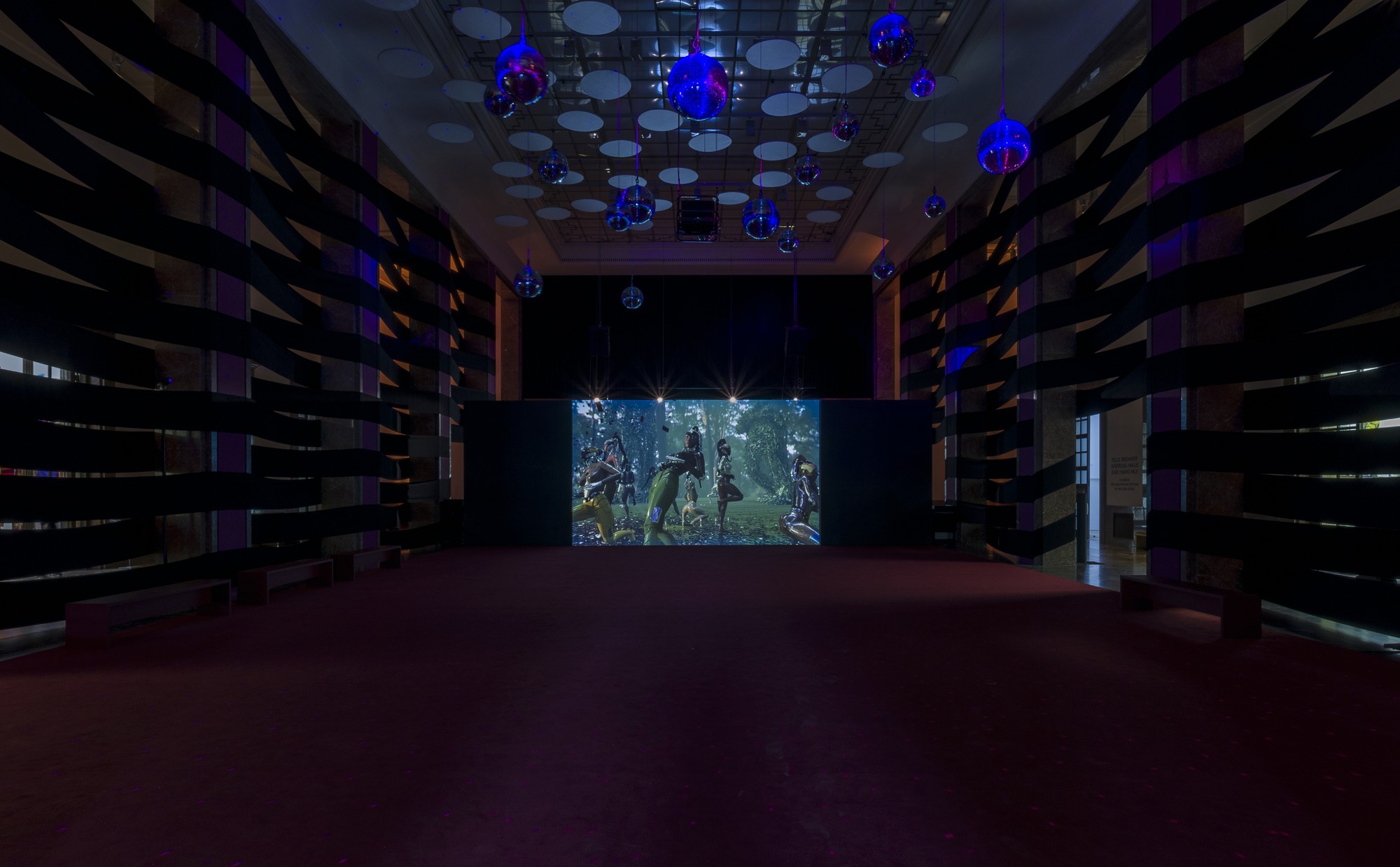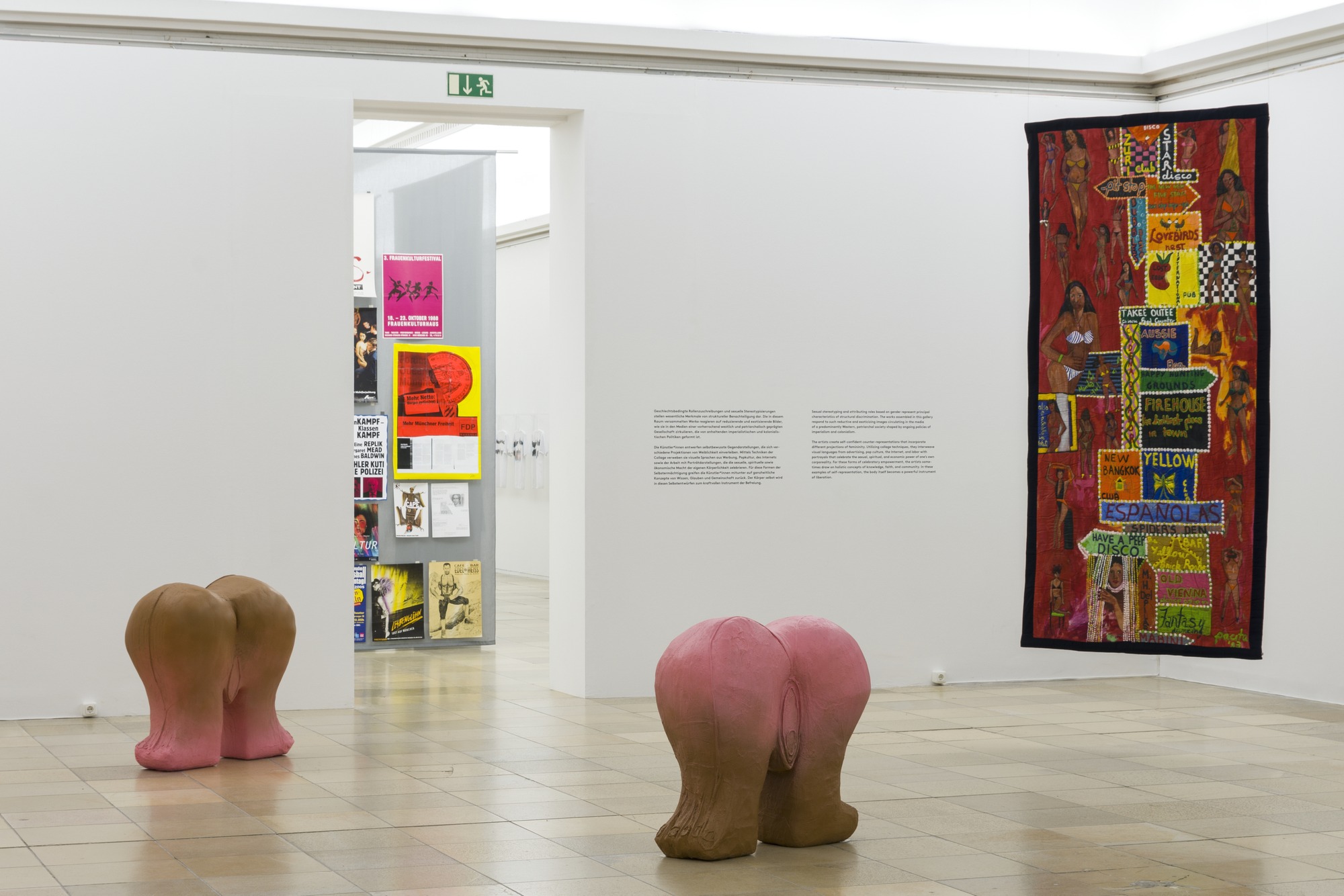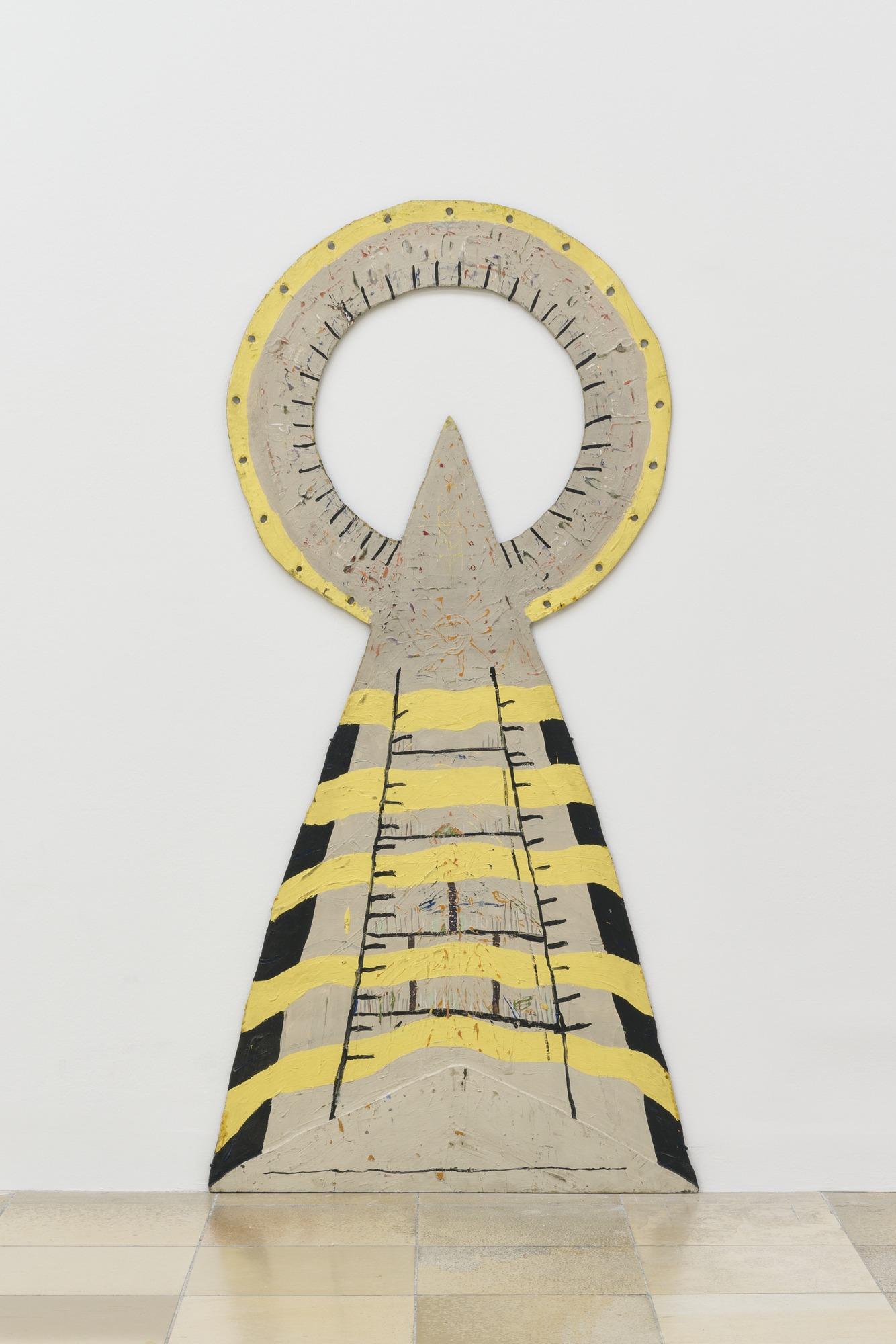Sweat
11 Jun 2021 - 09 Jan 2022

Jacolby Satterwhite
We Are In Hell When We Hurt Each Other, 2020
Installation view
Haus der Kunst, 2021
Photo: Maximilian Geuter
We Are In Hell When We Hurt Each Other, 2020
Installation view
Haus der Kunst, 2021
Photo: Maximilian Geuter

Jacolby Satterwhite
We Are In Hell When We Hurt Each Other, 2020
Installation view
Haus der Kunst, 2021
Photo: Maximilian Geuter
We Are In Hell When We Hurt Each Other, 2020
Installation view
Haus der Kunst, 2021
Photo: Maximilian Geuter
The human body produces sweat in reaction to emotive and physical stimuli as diverse as conflict, fear, attraction, repulsion, joy, sexual arousal, and stress. Orientated on bodies in motion, the exhibition “Sweat” tells of pleasurable self-empowerment and resistance.
The thirty artistic voices gathered here evolved in different places, at different times, and under different social pressures and conditions. The respective experiences of exclusion and oppression – with regard to culture, gender, origin, social class, and sexuality – are not weighed or delimited against each other. Rather, “Sweat” aims to draw attention to the complexity of different realities and to establish sensory approaches to current social discourses.
With poetic joy, the artists defend themselves against violent societal attempts to control their bodies. For example, with his work “We Are In Hell When We Hurt Each Other” (2020), Jacolby Satterwhite (b. 1986, USA) transforms Haus der Kunst’s Middle Hall in a night club environment, inhabited by an immersive video projection in which dancing avatars and mesmerising landscapes, function as extensions of the body. Satterwhite fuses the aesthetics of music videos and computer games, queer club culture and voguing, western contemporary art history of performance and African rites, with personal video and sound recordings. “Shrines” (2020), the second part of this video installation presented for the first time in an European museum, will be premiered in October 2021.
“MAY BE HERE MAYBE HE RE” (2021), a new expansive painting by Christine Sun Kim (b. 1980, USA) situated at the exhibition entrance captures the connection between sound and movement. Kim often visualizes diverse emotional states she has experienced in the face of her exclusion from public institutions, the media, and the art world in particular – spaces lacking sufficient access to non-verbal communication. In this new, site-specific painting, she repeats the visually similar gestures for “maybe” and “here” in American sign language with their written equivalents. The representations of hands with arrow symbols condense into a rhythmic and kinetic pattern.
As a transatlantic, community-building practice of masquerade, dance, and the improvised occupation of public space, carnival is also a central topic in the exhibition. It is introduced here by António Ole (b. 1951, Angola), whose film “Carnaval da Vitória” (1978) explores the re-established street carnival in Luanda and Angola’s anti-colonial struggle for self-determination. The sculptures by Daniel Lind-Ramos (b. 1953, Puerto Rico) build on this theme as well. Made of found objects, such as masks, musical instruments, textiles, and sporting goods, the works serve as the poetic archives of the musical traditions, social conflicts, ancestral spirituality, and political resistance of the artist’s native Puerto Rico.
With “Great Goddess Cut-Outs” (1974–75), Mary Beth Edelson (b. 1933, USA; d. 2021, USA) pays homage to the female body. In this sculpture series, the artist depicts archaic deities and ancestral worlds, exploring the formal connection between the feminine and the divine. Contemporary versions of this demand to define the imagery of one’s own body are also evident, for example, in the digital selfportraits of Tabita Rezaire (b. 1989, France) with which the artist sheds light on archetypal attributions ascribed to Black women. Tschabalala Self (b. 1990, USA) also articulates and adopts different attitudes towards the Black female body in her portraits and sculptures. In her wearable textiles, Zadie Xa (b. 1983, Canada) combines western pop culture with traditional South Korean mythology. As the symbol of life’s origin and the traditional myths of the matriarchal “home,” the oceans of the world frequently nourish the artist’s visual vocabulary.
“What is danced nobody can take away from me”
This declaration, made by Santiago Reyes, who becomes increasingly sweat-drenched during his dance performance “Dancing Southward” (2016-) could serve as the motto for the transgenerational and transnational stories of physical resistance gathered in “Sweat.” The overview exhibition of works, spanning from the recent present to the pioneering feminist, queer, and postcolonial positions of the 1970s and 1980s, shows how artists have been representing and standing for the transformations of the politics of the body, and how artistic languages have been always ahead of time in shaping culture and cultural shifts over the decades.
The exhibition is accompanied by a catalogue published by K-Verlag, with contributions by Olamiju Fajemisin, Raphael Fonseca, André Lepecki, Miguel A. López, Renée Mboya, Anna Schneider, Elena Setzer, Claire Tancons and Helena Vieira.
Curated by Anna Schneider and Raphael Fonseca; curatorial assistant: Elena Setzer
With works by Pacita Abad, Cecilia Bengolea, Mohamed Bourouissa, chameckilerner, Mary Beth Edelson, Philipp Gufler, Sunil Gupta, Eisa Jocson, Isaac Julien, Christine Sun Kim, Daniel Lind-Ramos, Natalia LL, MAHKU (Movement of Huni Kuin Artists), MPA, Mulambö, António Ole, Santiago Reyes, Tabita Rezaire, Michele Rizzo, Guadalupe Rosales, Jacolby Satterwhite, Tschabalala Self, Tuesday Smillie, João Pedro Vales + Nuno Alexandre Ferreira, Kaylene Whiskey, Zadie Xa.
Media partner: Monopol
The thirty artistic voices gathered here evolved in different places, at different times, and under different social pressures and conditions. The respective experiences of exclusion and oppression – with regard to culture, gender, origin, social class, and sexuality – are not weighed or delimited against each other. Rather, “Sweat” aims to draw attention to the complexity of different realities and to establish sensory approaches to current social discourses.
With poetic joy, the artists defend themselves against violent societal attempts to control their bodies. For example, with his work “We Are In Hell When We Hurt Each Other” (2020), Jacolby Satterwhite (b. 1986, USA) transforms Haus der Kunst’s Middle Hall in a night club environment, inhabited by an immersive video projection in which dancing avatars and mesmerising landscapes, function as extensions of the body. Satterwhite fuses the aesthetics of music videos and computer games, queer club culture and voguing, western contemporary art history of performance and African rites, with personal video and sound recordings. “Shrines” (2020), the second part of this video installation presented for the first time in an European museum, will be premiered in October 2021.
“MAY BE HERE MAYBE HE RE” (2021), a new expansive painting by Christine Sun Kim (b. 1980, USA) situated at the exhibition entrance captures the connection between sound and movement. Kim often visualizes diverse emotional states she has experienced in the face of her exclusion from public institutions, the media, and the art world in particular – spaces lacking sufficient access to non-verbal communication. In this new, site-specific painting, she repeats the visually similar gestures for “maybe” and “here” in American sign language with their written equivalents. The representations of hands with arrow symbols condense into a rhythmic and kinetic pattern.
As a transatlantic, community-building practice of masquerade, dance, and the improvised occupation of public space, carnival is also a central topic in the exhibition. It is introduced here by António Ole (b. 1951, Angola), whose film “Carnaval da Vitória” (1978) explores the re-established street carnival in Luanda and Angola’s anti-colonial struggle for self-determination. The sculptures by Daniel Lind-Ramos (b. 1953, Puerto Rico) build on this theme as well. Made of found objects, such as masks, musical instruments, textiles, and sporting goods, the works serve as the poetic archives of the musical traditions, social conflicts, ancestral spirituality, and political resistance of the artist’s native Puerto Rico.
With “Great Goddess Cut-Outs” (1974–75), Mary Beth Edelson (b. 1933, USA; d. 2021, USA) pays homage to the female body. In this sculpture series, the artist depicts archaic deities and ancestral worlds, exploring the formal connection between the feminine and the divine. Contemporary versions of this demand to define the imagery of one’s own body are also evident, for example, in the digital selfportraits of Tabita Rezaire (b. 1989, France) with which the artist sheds light on archetypal attributions ascribed to Black women. Tschabalala Self (b. 1990, USA) also articulates and adopts different attitudes towards the Black female body in her portraits and sculptures. In her wearable textiles, Zadie Xa (b. 1983, Canada) combines western pop culture with traditional South Korean mythology. As the symbol of life’s origin and the traditional myths of the matriarchal “home,” the oceans of the world frequently nourish the artist’s visual vocabulary.
“What is danced nobody can take away from me”
This declaration, made by Santiago Reyes, who becomes increasingly sweat-drenched during his dance performance “Dancing Southward” (2016-) could serve as the motto for the transgenerational and transnational stories of physical resistance gathered in “Sweat.” The overview exhibition of works, spanning from the recent present to the pioneering feminist, queer, and postcolonial positions of the 1970s and 1980s, shows how artists have been representing and standing for the transformations of the politics of the body, and how artistic languages have been always ahead of time in shaping culture and cultural shifts over the decades.
The exhibition is accompanied by a catalogue published by K-Verlag, with contributions by Olamiju Fajemisin, Raphael Fonseca, André Lepecki, Miguel A. López, Renée Mboya, Anna Schneider, Elena Setzer, Claire Tancons and Helena Vieira.
Curated by Anna Schneider and Raphael Fonseca; curatorial assistant: Elena Setzer
With works by Pacita Abad, Cecilia Bengolea, Mohamed Bourouissa, chameckilerner, Mary Beth Edelson, Philipp Gufler, Sunil Gupta, Eisa Jocson, Isaac Julien, Christine Sun Kim, Daniel Lind-Ramos, Natalia LL, MAHKU (Movement of Huni Kuin Artists), MPA, Mulambö, António Ole, Santiago Reyes, Tabita Rezaire, Michele Rizzo, Guadalupe Rosales, Jacolby Satterwhite, Tschabalala Self, Tuesday Smillie, João Pedro Vales + Nuno Alexandre Ferreira, Kaylene Whiskey, Zadie Xa.
Media partner: Monopol





